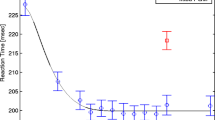Abstract
The effects of the duration of presentation of stimuli on the reaction time for detection of gratings of different spatial frequencies were studied. The product of contrast and duration (the contrast “energy”) was kept constant for each duration. These experiments showed that at near-threshold “energies,” reaction times did not change with increases in the duration to 15 and 30 msec at low and high spatial frequencies respectively. At high contrast “energies,rd this critical duration was identical (15 msec) for both low and high spatial frequencies. The effects of the duration of a linearly increasing front for grating presentation on detection reaction times were also studied. Increases in the duration of the front (to 60 msec) significantly lengthened the reaction time at low spatial frequencies at all contrast levels studied. Conversely, at high spatial frequencies, a significant increase in the reaction time was seen only at high contrast levels. These results suggest that reaction time depends on two types of mechanisms (phasic and tonic) at nearthreshold contrast and one type (phasic) at high contrast.
Similar content being viewed by others
REFERENCES
V. D. Glezer, V. A. Ivanov, and T. A. Shcherbach, “Studies of the receptive fields of cat visual cortex neurons as spatial frequency filters,” Fiziol. Zh. SSSR, 59, 206–214 (1973).
J. M. Barr, A Study of Visual Detection Latencies Using Stimuli of Varying Spatial Frequency, Ph.D. Thesis, Oxford, UK (1986).
C. Blakemore and R. W. Campbell, “On the existence of neurones in the visual system selectively sensitive to the orientation and size of retinal images,” J. Physiol., 203, 237–260 (1969).
B. G. Breitmeyer, “Simple reaction time as a measure of the temporal response properties of transient and sustained channels,” Vision Res. (1998).
C. Bonnet, J. Gurlekian, and P. Harris, “Reaction time and the visual area: searching for determinants, ” Bull. Psychonom. Soc., 30, 396–398 (1992).
F. W. Campbell and R. W. Gubish, “Optical quality of the human eye,” J. Physiol., 186, 558–578 (1966).
F. W. Campbell and J. G. Robson, “Application of Fourier analysis to the visibility of gratings,” J. Physiol., 197, 551–556 (1968).
A. Felipe, M. J. Buades, and J. M. Artigas, “Influences of the contrast sensitivity function on the reaction time,” Vision. Res., 33, 2461–2466 (1993).
N. Graham, “Detection and identification of near-threshold visual patterns,” J. Opt. Soc. Amer., A, No.2, 1468–1482 (1985).
N. Graham and J. Nachmias, “Detection and identification of grating patterns containing two spatial frequencies. A comparison of single-channel and multiple-channel models,” Vision Res., 11, 251–259 (1971).
R. S. Harwerth and D. M. Levi, “Reaction time as a measure of suprathreshold grating detection,” Vision. Res., 18, 1579–1586 (1978).
R. Jones and M. J. Keck, “Visual evoked response as a function of grating spatial frequency,” Invest. Ophthalmol. Visual. Sci., 17, 652–659 (1978).
J. J. Kulikowski and D. J. Tolhurst, “Psychophysical evidence for sustained and transient detectors in human vision,” J. Physiol., 232, 149–162 (1973).
G. E. Legge, “Sustained and transient mechanisms in human vision. Temporal and spatial properties,” Vision Res., 18, 69–81 (1978).
U. Lupp, G. Hauske, and W. Wolf, “Perceptual latencies to sinusoidal gratings,” Vision Res., 16, 969–972 (1976).
R. J. W. Mansfield, “Latency fusions in human vision,” Vision Res., 13, 2219–2234 (1973).
D. Mitov, Investigation of Some Temporal Characteristics of Grating Perception, Ph.D. Thesis, Institute of Physiology, Bulgarian Academy of Sciences (1983).
D. Mitov, “How many channels determine the RT to grating onset detection?” Perception, 28, Supplement, 103–104 (1999).
D. Mitov and H. Gigov, “A hybrid system for automated visual investigation,” Perception, 16, Supplement, 244 (1987).
D. Mitov and C. Totev, “Does spatial frequency and contrast uncertainty influence reaction time?” Perception, 29, Supplement, 116 (2000).
J. Nachmias, “Effect of exposure duration on visual contrast sensitivity with square-wave gratings, ” J. Opt. Soc. Amer., 57, 421–427 (1967).
L. A. Olzak and J. P. Thomas, in: Handbook of Perception and Human Performance, K. R. Boff, L. Kaufman, and J. P. Thomas (eds.),Vol. 1: Sensory Processes and Perception, Wiley Interscience, New York (1986), pp. 7.1-7.56.
D. M. Parker and E. A. Salzen, “Latency changes in the human visual evoked response to sinusoidal gratings,” Vision Res., 17, 1201–1204 (1977).
N. F. Podvigin, A. M. Cooperman, V. D. Glezer, and I. V. Chueva, “Changes of the region of summation of cat’s corpus geniculatum lateralis in time due to illumination. The role of excitation and inhibition in this process, ” Biofizika, 18, 535–543 (1973).
M. Saleh and C. Bonnet, “Reaction time and retinal operation,” in: Fechner Day 98, S. Gondrin and J. Lacoutre (eds.), Quebec (1998), pp. 344–348.
M. Saleh and C. Bonnet, “Probability summation in the Piéron function,” in: Fechner Day 2000, C. Bonnet (ed.), ISP, Strasbourg (2000).
J.P. Thomas, P. Fagerholm, and C. Bonnet, “One spatial filter limits speed of detecting low and middle frequency gratings,” Vision Res., 39, 1683–1693 (1999).
D. J. Tolhurst, “Reaction time in the detection of gratings by human observers. A probabilistic mechanism,” Vision. Res., 15, 1143–1149 (1975).
A. Vassilev and D. Mitov, “Spatial frequency and the speed of visual information processing,” Abstracts, 97 (1974).
A. Vassilev and D. Mitov, “Perception time and spatial frequency,” Vision Res., 16, 89–92 (1976).
A. Vassilev, M. Mihaylova, and C. Bonnet, “On the delay in processing high spatial frequency visual information: reaction time and VEP latency study of the effect of local intensity of stimulation,” Vision Res., 42, 851–864 (2002).
A. Vassilev and D. Strashimirov, “On the latency of human visually evoked response to sinusoidal gratings,” Vision. Res., 19, 843–845 (1979).
A. Vassilev, D. Mitov, and D. Strashimirov, “Human visually evoked responses and temporal summation of suprathreshold sinusoidal gratings,” Comptes Rendus de l’Academie Bulgare des Sciences, 33, 837–840 (1980).
Author information
Authors and Affiliations
Additional information
Translated from Rossiiskii Fiziologicheskii Zhurnal imeni I. M. Sechenova, Vol. 89, No. 10, pp. 1240–1249, October, 2003.
Rights and permissions
About this article
Cite this article
Mitov, D.L., Totev, T.T. Temporal summation and reaction times for detecting gratings. Neurosci Behav Physiol 35, 417–422 (2005). https://doi.org/10.1007/s11055-005-0042-0
Received:
Revised:
Issue Date:
DOI: https://doi.org/10.1007/s11055-005-0042-0




